Easel Painting (Vermeer)
| Date: | 1976
|
| Medium: | Oil on canvas |
| Size inches: | c. 23 1/2 x 19 3/4 |
| Size cm: | 60 x 50
|
| Signature: | |
| |
| Location: | Robert H. Orchard Collection, St. Louis, Missouri |
George Deem … has based much of his work on Vermeer's paintings, studying their color, cropping, pictorial structure, and attention to natural light. …Deem has not subsumed Vermeer's images under his own creations but has celebrated his connections with the Delft master through his imaginative reinterpretations of Vermeer's paintings. In his
Easel Painting (1976), Deem has moved the narrative moment of Vermeer's
Art of Painting ahead in time. Here, the artist and model have left the studio with the completed painting displayed prominently on its easel …Deem's reassessments of Vermeer's images pay homage to the master, but they also are strangely disquieting in the way they hint at life beyond the carefully constructed confines that Vermeer reveals in his images. (Arthur K. Wheelock, Jr. and Marguerite Glass, "The Appreciation of Vermeer in Twentieth-Century America,"
The Cambridge Companion to Vermeer, ed. Wayne E. Franits, New York: Cambridge University Press, 2001)
In (a) painting based on
The Art of Painting titled
Easel Painting (1976), Deem moves Vermeer's subject ahead in time. In
Easel Painting, the artist and model have left the studio, leaving the completed painting displayed prominently on its easel, positioned within the precise room environment established by Vermeer. In another painting from the same year titled
Vermeer Interior, Deem reconceptualizes
The Art of Painting within the context of Vermeer's
The Music Lesson. To create this work, Deem widens the space of the room, adjusts the lighting, moves the figure of the artist closer to the viewer, and creates a platform on which he can be placed so that his same posture and position is maintained. In both
Easel Painting and
Vermeer Interior, Deem conveys much of the essential character of Vermeer -- his choice of palette, calculated compositional design, and attention to natural light -- yet through his combinations and extensions of original Vermeer ideas Deem asserts a new dynamic that is all his own. (Marguerite Anne Glass,
Vermeer In Dialogue: From Appropriation To Response,PhD Dissertation, 2003, Department of American Studies, University of Maryland)
drum.lib.umd.edu/bitstream/1903/45/1/dissertation.pdf



